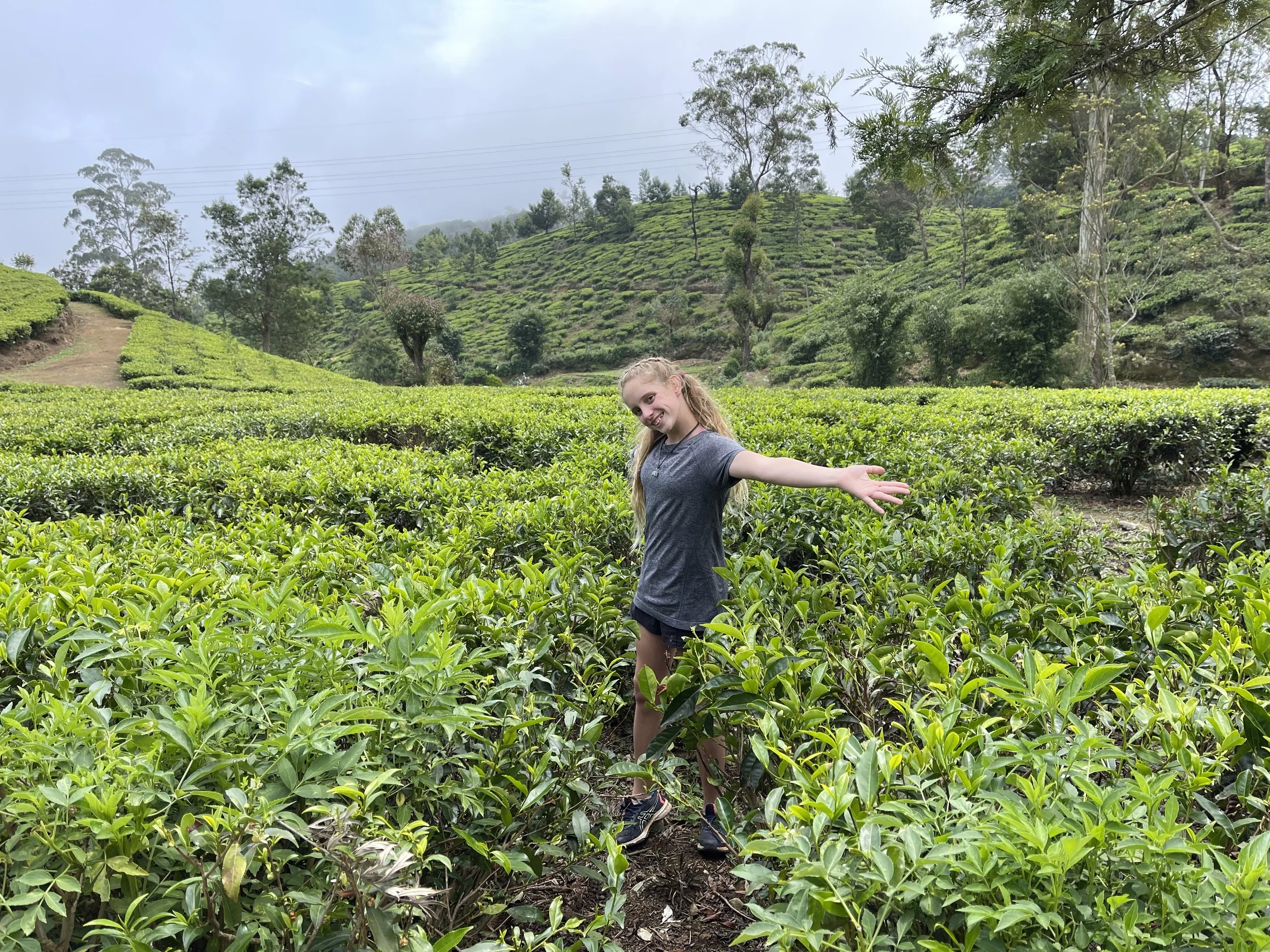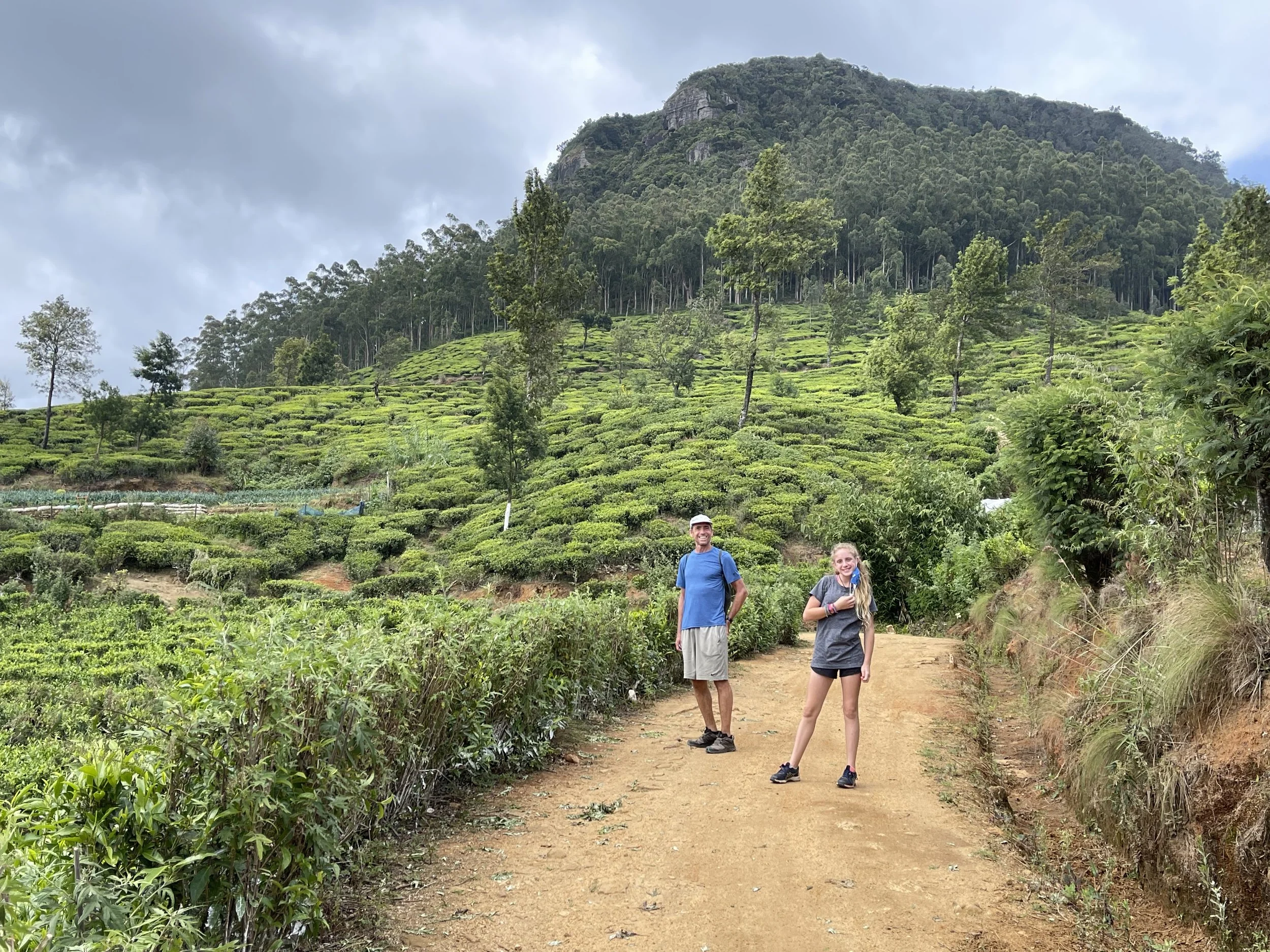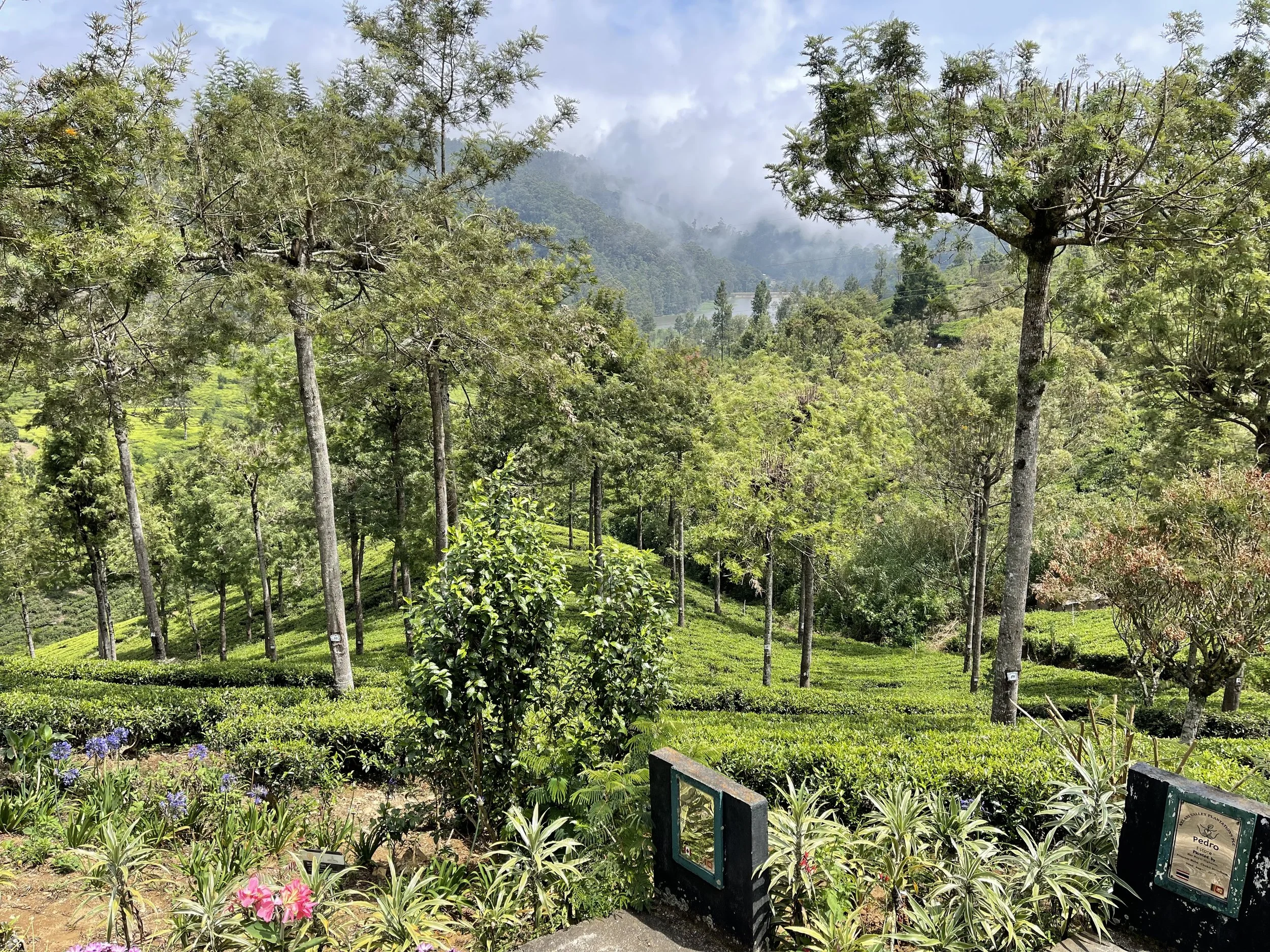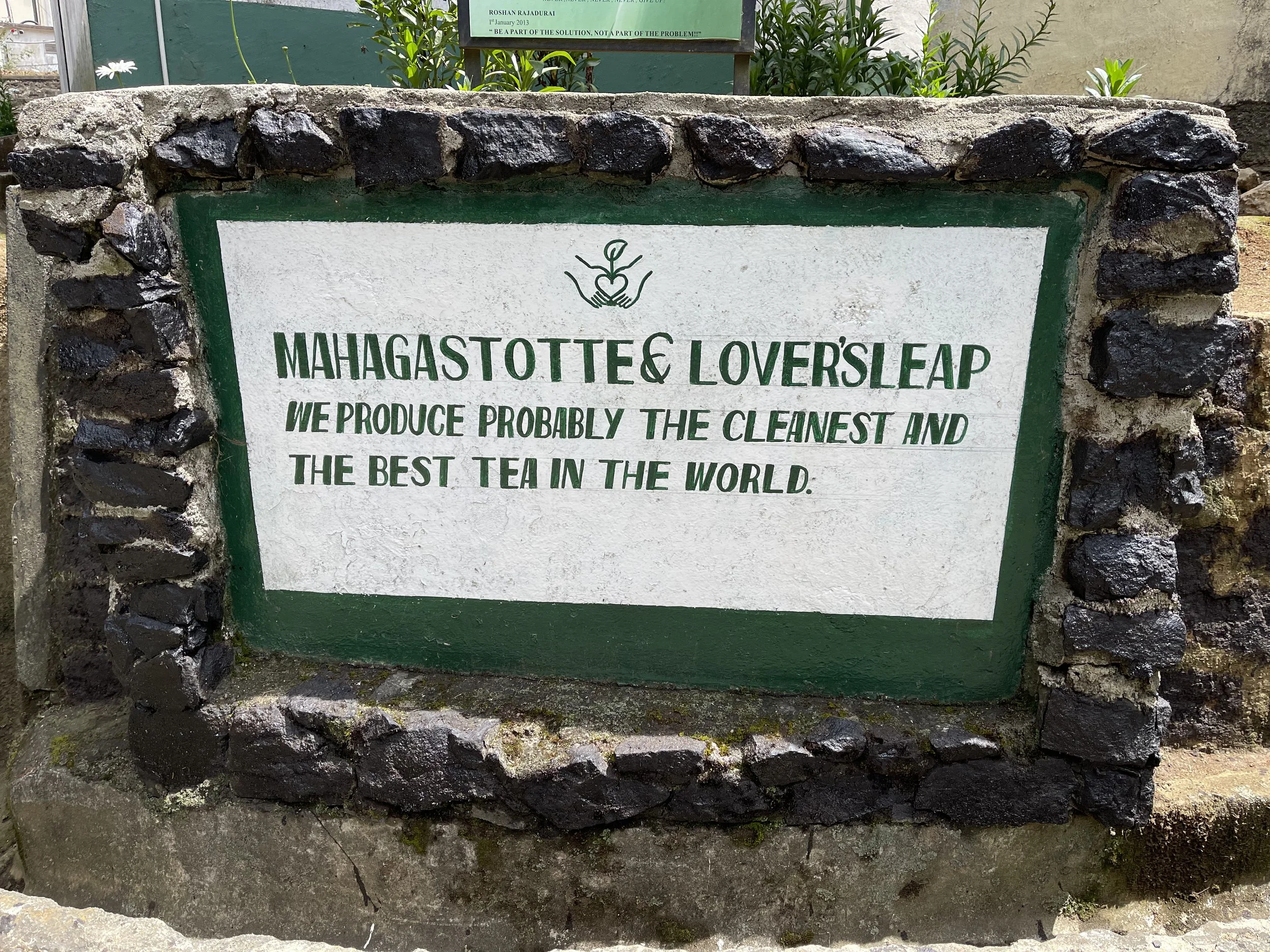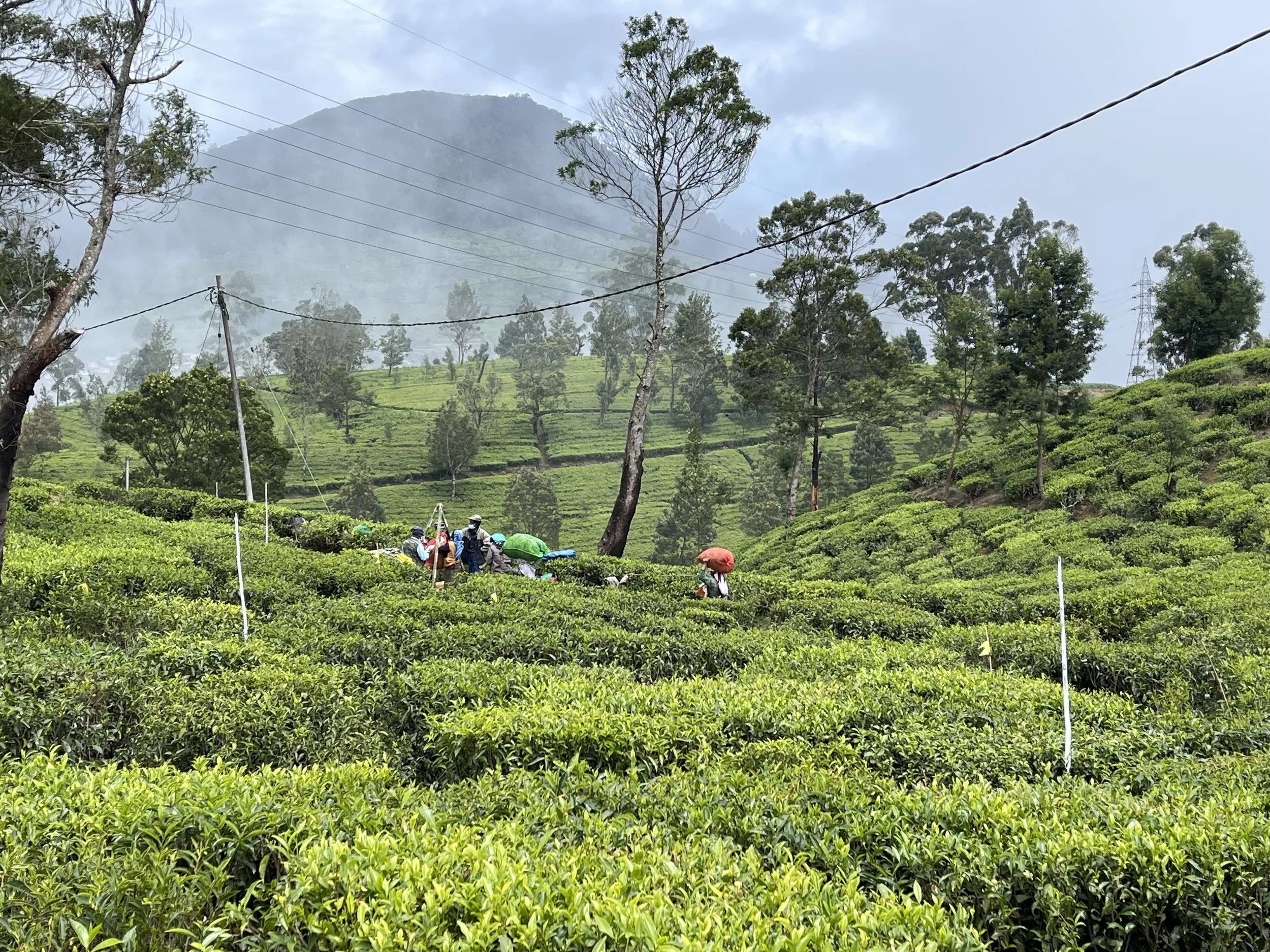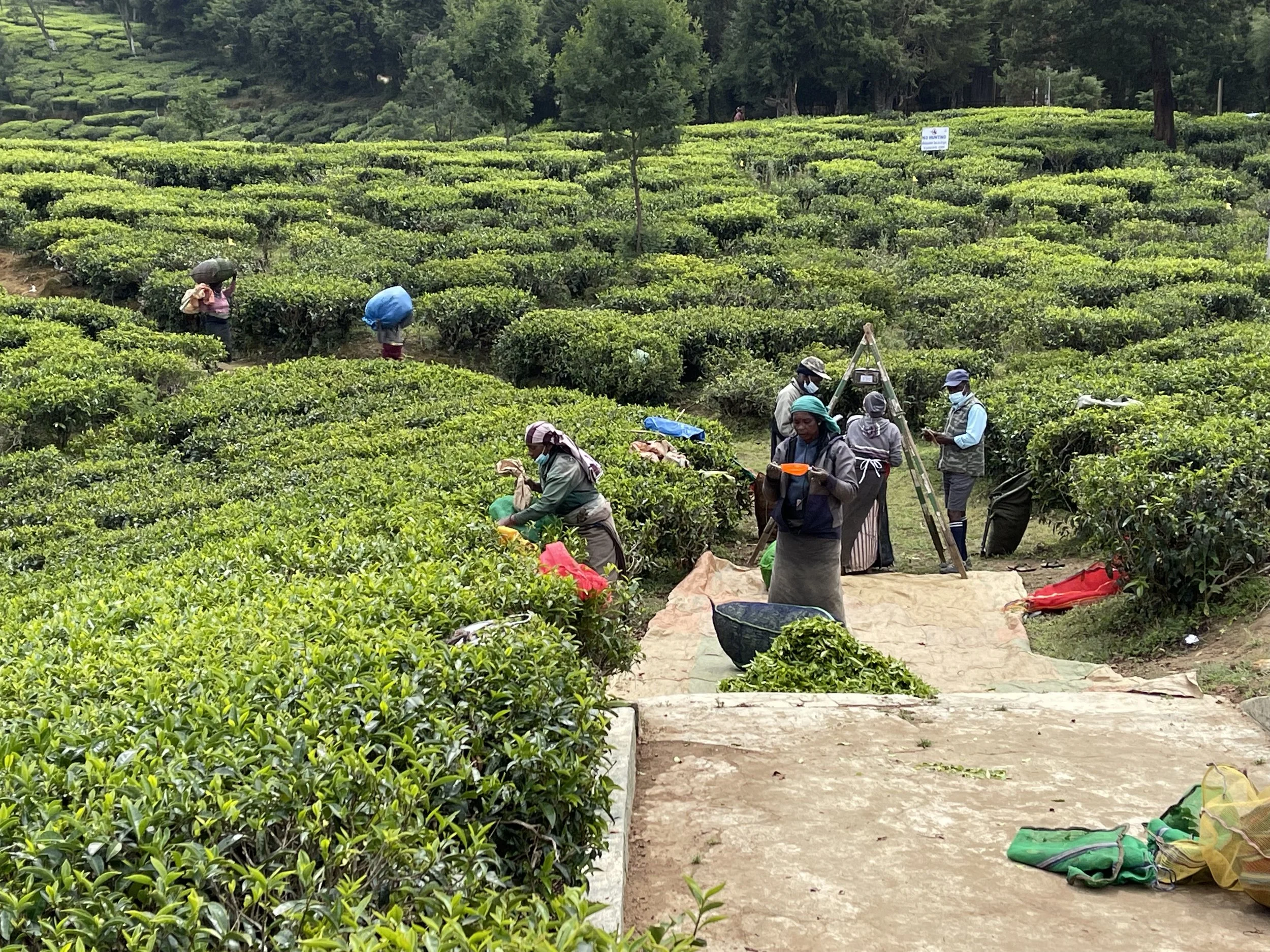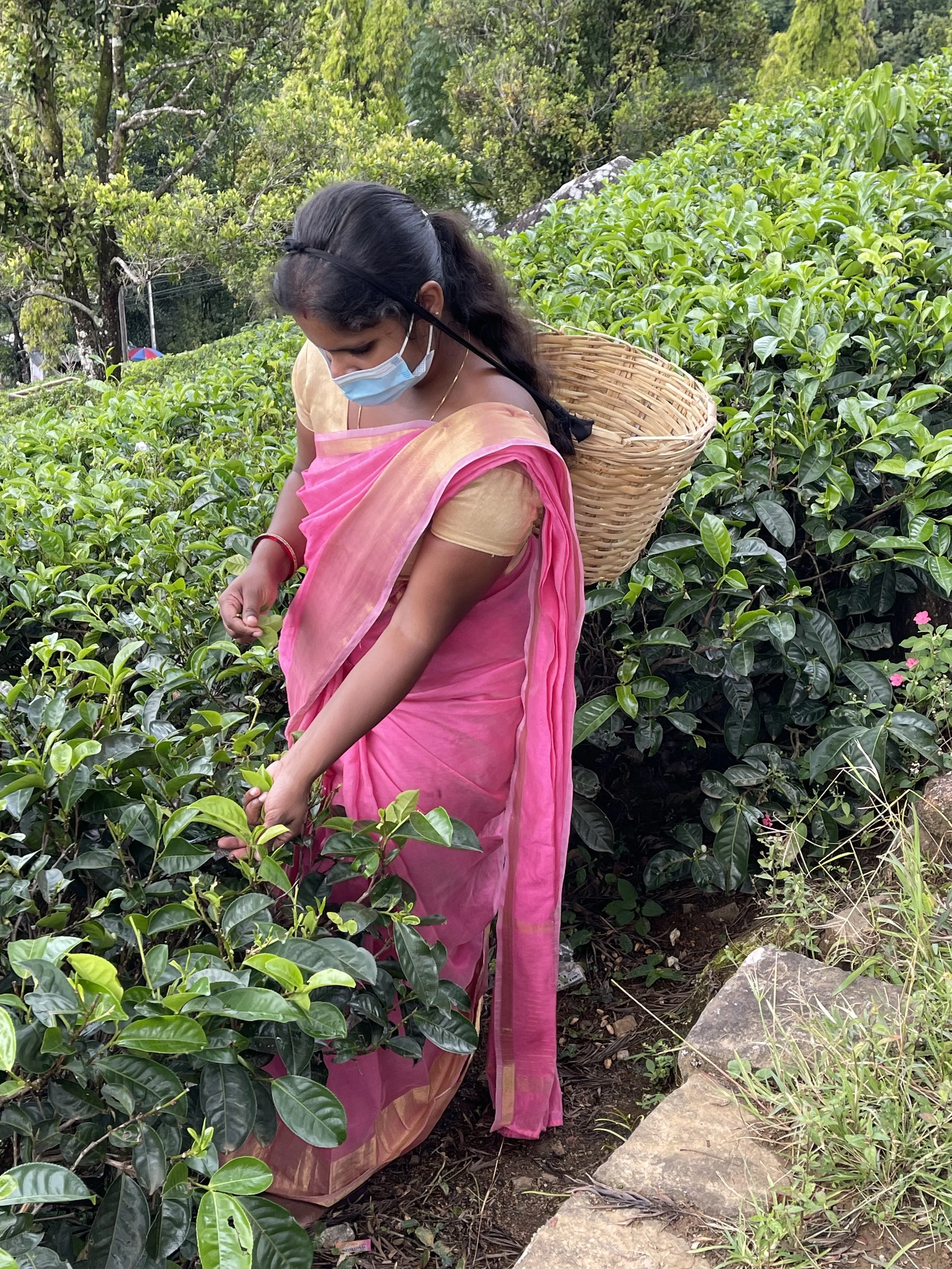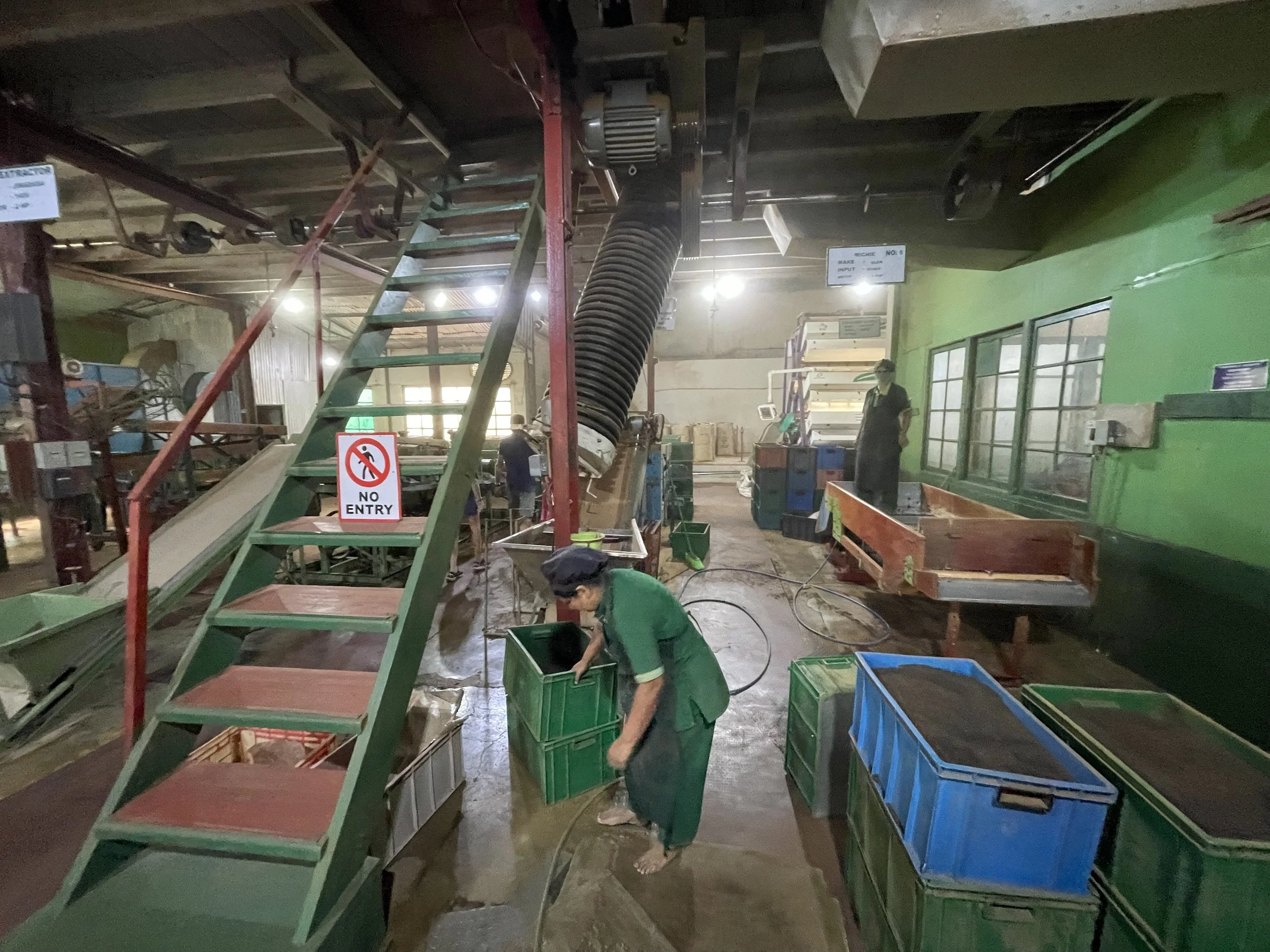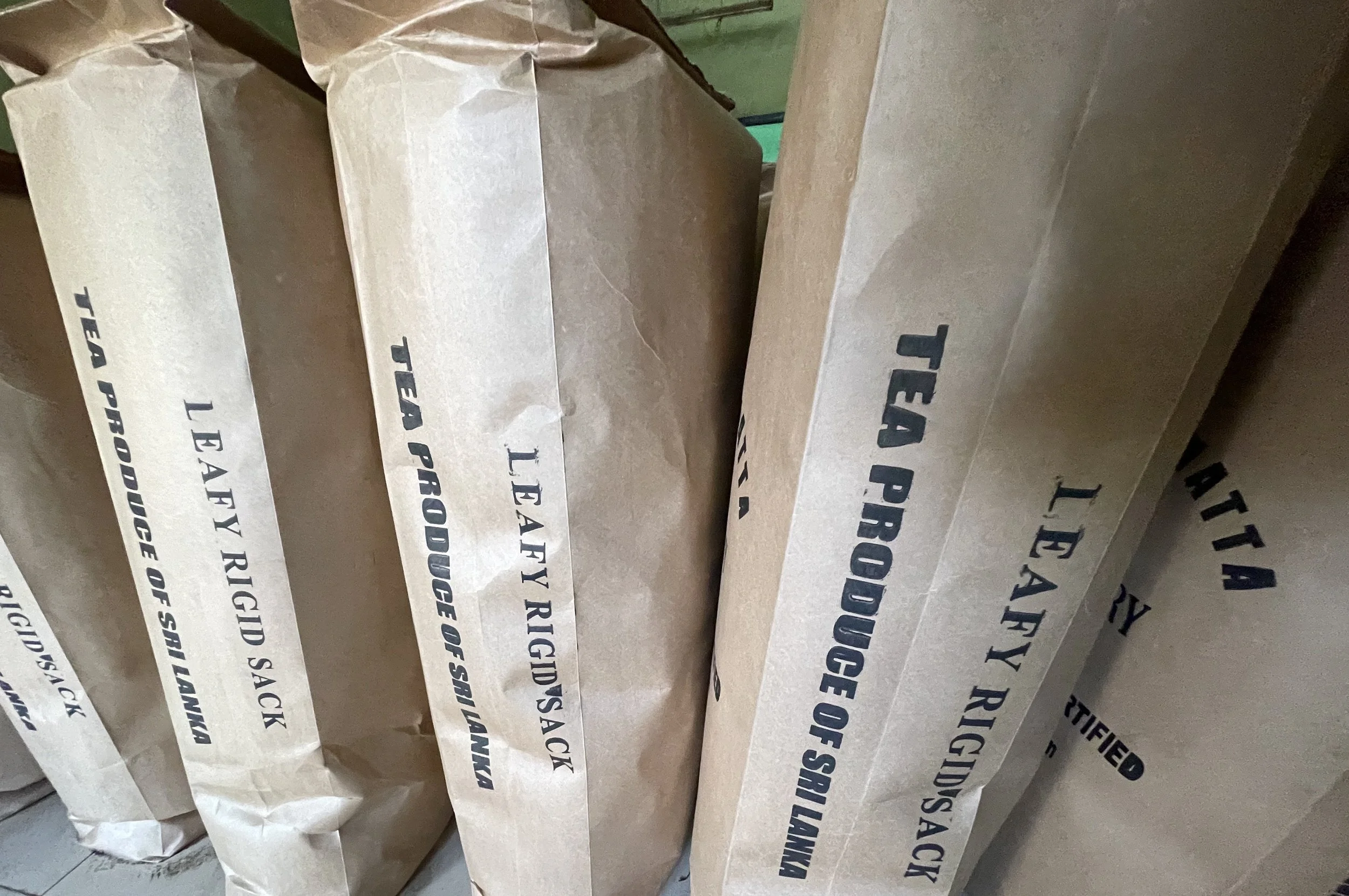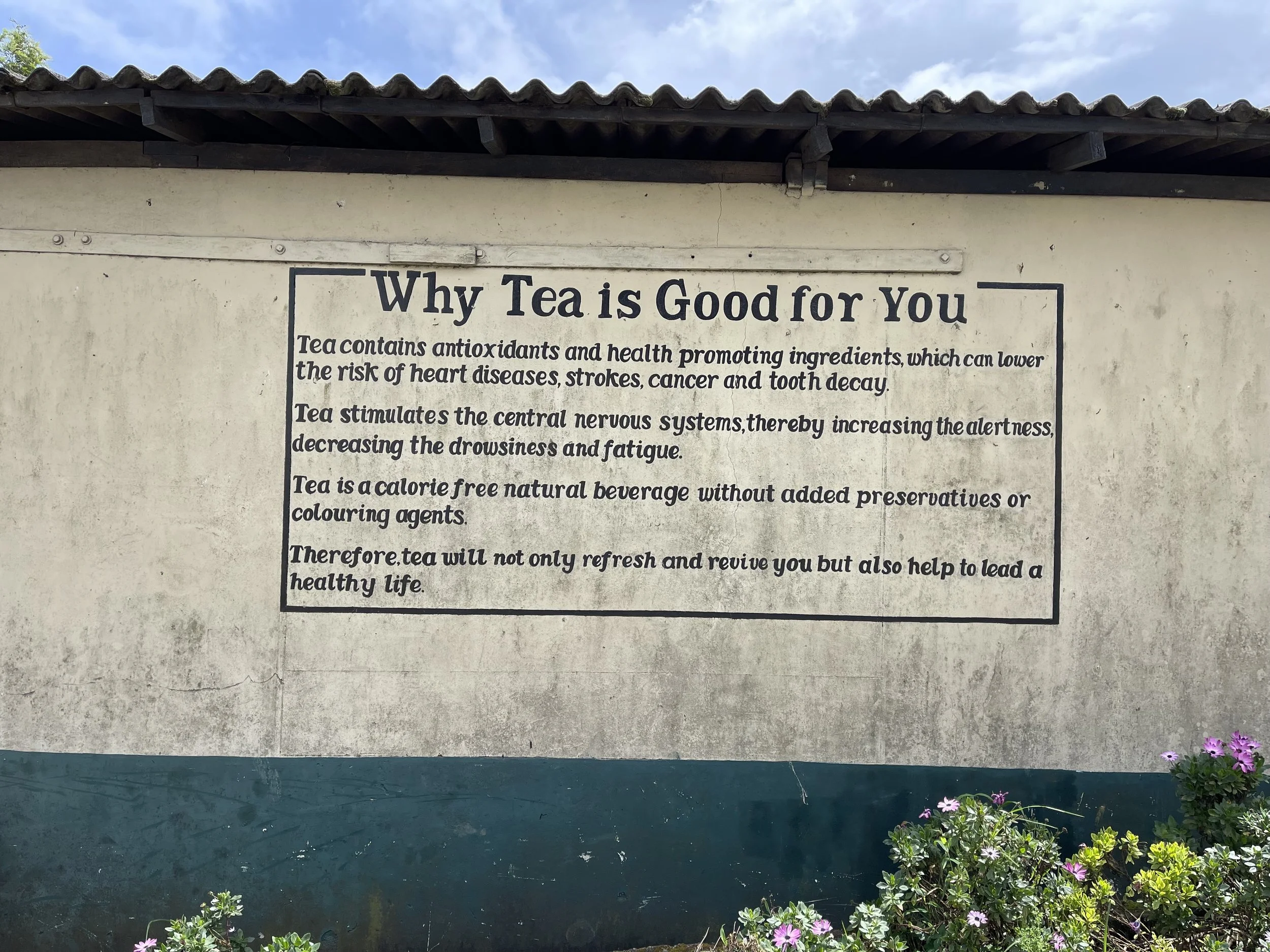Prepare Yourself: Let’s Get the Par-TEA Started
A high pitched whistle let me know it was ready. I poured steaming water in a porcelain cup. After a few minutes, I removed the Orange Pekoe leaves resting at the bottom. Steam billowing in my face, I took a sip. It smelled so good and earthy. It was a rich copper color. I removed the cup from my lips. I coughed and sputtered.
“Is this supposed to taste good?” I exclaimed, between coughs since the taste was so bitter. I guess it must taste good, because people have been drinking tea in Sri Lanka for nearly 200 years. Looking for a distraction from the bitter taste left in my mouth, I looked out over the stunning valleys covered in tea trees. The tea trees are especially pretty since they're a vivid springtime green and glossy.
“Mmmm.. that’s good,” My dad sighed. I looked away from the mountains to stare at my dad in shock. My mom and I looked at him with our eyes bulging.
I later learned that the tea I drank was the strongest of the teas. It just seems like you could put any leaf in hot water and get this! Who came up with this?
The Legends Of Tea
It turns out that the history of tea dates back to 2737 BC in China. There are two main legends on how Shen Nung first discovered tea as early as six thousand years ago. Shen Nung was the mythical Chinese inventor of agriculture. The first legend has it that he was a farmer wandering through the forests attempting to find edible plants and herbs. He, however, poisoned himself multiple times. Before he was about to die, a leaf drifted into his mouth. He chewed on it, and was cured according to a legend at least.
The other legend states that the emperor Shen Nung was sitting under a tree while his servant boiled water to drink. At that moment, a leaf drifted in his cup and tea was born. These are just legends and there is no definite way to know how tea was born. While there is no official beginning, we can be sure that it took place in China, and it involved a man named Shen Nung.
The History of Tea
Tea has been around for a long time, and the first tea plants used are the very same variety currently grown in China and other parts of the world today. However, the way we consume it is very different now. Instead of the familiar method of putting loose leaves in hot water, it was first eaten as a vegetable in salad, or cooked with grain porridge. It wasn’t until 1,500 years ago, when tea changed from a food to a drink. The standard way to cook tea was to heat the leaves, make them into a thin cake, and turn it into a powder. Following that you would add water. The drink was called matcha. Interestingly, it was a favorite drink of emperors, and people would draw unique pictures in the foam, which is similar to coffee art today.
It was none other than a Japanese monk who brought tea to Japan in the 9th century. The Japanese then created their own tea rituals and ceremonies.
In the 14th century a Chinese emperor changed the standard tea consumption from a cake, to loose leaf tea. It was during this time China had the only tea plants, making it one of their top three exported goods along with silk and porcelain. This of course gave China a lot of power.
The love of tea spread around the world when Dutch ships brought tea to Europe. The tea business led to innovation in ship construction in order to bring tea to Europe faster, since this would lead to the most profits. It is believed that Queen Catherine of Braganza made tea popular in the UK after she married the British King, Charles II In 1661. As Great Britain rule grew, the love of tea did too. Tea became so beloved that it was worth ten times as much as coffee.
For a long time Great Britain paid for all their tea with silver. That became too expensive. Britain suggested that instead of money, there would be an exchange of goods. Britain traded opium for tea with China, which caused many health problems, as the Chinese became addicted to opium. One of the Chinese rulers ordered his men to destroy the British ships of opium, which resulted in the Opium War. The war occurred all along China's coast until 1842, ending up in Britain's rule over the ports of Hong Kong.
The East India Company was determined to grow and produce their own tea plants like they do in China, so they sent botanist Robert Fortune to steal tea manufacturing secrets from China. Now, knowing how to manufacture tea, the drink blossomed globally and grew into the beloved drink it is today. So loved in fact, that it is the second most popular drink, after water.
Love the humility
History of Tea in Ceylon (Sri Lanka)
As weird as it might sound, the history of tea began in this island nation with coffee. In 1780, the first commercial coffee plants were planted in Ceylon. Ceylon, which is now called Sri Lanka, was under British rule at this time. This process was started and first overseen by the Dutch, then the British took it over. The coffee industry was going really well. In fact, over 1,060 square miles of Ceylon were covered with coffee plants. Then in 1869, disaster struck. It was an epidemic of the fungus Hemileia vastatrix, also known as coffee rust. The disease causes the leaves to shrivel up, die, then fall off. Many coffee farmers had to tear their coffee plants out of the ground. Disappointed, the farmers were looking for a new opportunity. They found tea was the answer, since it grew wonderfully in the mountainous regions.
Now knowing the ghost of coffee was looming in the background, I wanted to know how tea got there and saved them. I discovered that the Chinese gave the first tea plant to the British in 1824. The British then gave it to Ceylon. It was then planted in the Royal Botanical Gardens in Kandy for non-commercial purposes. More experimental tea plants were sent by the East India Company. Ceylon tea went big, but it started with two guys. The two big names in Ceylon tea are Thomas Lipton and James Taylor. These men were instrumental in the planting and construction of the tea and tea factories. You might recognize the name Lipton. It is the very same Lipton tea of the slogan “picked at the peak of freshness” we drink now, which was created in 1890. James Taylor was only 17 when he came to Ceylon. You also might recognize the name James Taylor too. It’s not the same one who had Carolina on his mind, like me, but he definitely had Ceylon on his mind.
Ceylon tea was small, but changed many things. The original tea plantation was only 19 acres. James Taylor began operating a fully equipped tea factory on the grounds of the Loolecondera Estate in 1872. It was only in 1873 that the first shipment of Ceylon tea, a consignment of some 23 lb, arrived in London. Soon many other places switched from growing coffee to tea. Tea production in Ceylon increased dramatically in the 1880s and by 1888, tea was grown much more than coffee at nearly 400,000 acres in 1899. By the late 1880s, almost all the coffee plantations in Ceylon had been converted to tea. In addition, a lot of coffee factories were converted to tea production to keep up with the high demand. Tea processing technology rapidly developed in the 1880s, with a new type of dryer, and in 1877 the manufacturing of the first tea rolling machine occurred.
In the history of Ceylon tea there were many big moments. Most notably, in 1893 at the Chicago World's Fair, over 1 million packets of Ceylon tea were sold. That same year the tea set a record price of 40 dollars per lb at the London Tea Auctions. By the 1960s Ceylon produced over 220,000 lbs of tea. Ceylon was so big that it was the official supplier of tea at the 1980 Moscow Summer Olympic Games.
Tea from Ceylon was known to be some of the finest in the world. In addition, many people knew the name of the country from tea containers. However, when the country changed its name to Sri Lanka in 1972, its biggest industry was faced with a big problem. Ceylon was not only the former name of the country; it was also one of the world’s leading tea brands, familiar to consumers’ all over the world. Eventually, the government agreed to keep the name Ceylon tea.
How Tea is Made
What is the whole process of making tea? Well, it all starts with the pluckers. These women are incredible. They stand in steeply sloped tea fields all day with heavy bags on their head picking tea leaves. They have a basket or bag attached to a rope. The rope is on their forehead and the bag hangs behind them. They throw the leaves over their head and when they fill up the bag it gets weighed. These women only get 1,000 Sri Lankan rupees a day, which is equivalent to $4.95. The women work from 7:30 to 2:30 with one 30 minute break. A few years back, there was a push to increase their pay raise from 761.75 Sri Lankan rupees which is $3. 77. It was a long fight, but they won and got their pay increase.
Getting tea bags weighed
Our tour guide showing us how to pick tea
There are still many things that need to happen before you can enjoy your morning cup. After the tea is picked the leaves go through the withering process. The plucked tea leaves are brought to the factory where they are put into large withering troughs which fan hot air to reduce the moisture content of the tea leaf. I can confirm. It’s hot. Next the leaves are rolled. This is to break up the leaf. Also, to mix the natural chemicals found in the leaf. The leaves are then oxidized, otherwise known as fermentation. In this step, the leaves are spread in an even layer to oxidize the polyphenols, one of the main categories of chemicals found in tea. This fermentation affects the flavor of the tea. Also, the only type of tea that is fermented is black tea. This makes it the most flavorful. It is actually green tea that is believed to be the healthiest since it has the most polyphenols, which is the chemical that makes tea healthy. Following the fermentation is firing. The process of firing gets rid of most of the leaf moisture and stops fermentation. Next, is sorting. This is where the tea leaves are sorted based on their size. Lastly is packing and shipping. The finished tea leaves are put in big bags that can weigh 80 lbs. These bags are shipped to Colombo and many other places from there. There are also tea auctions in Colombo. The bags can be sold for $300. It may sound like a lot but, after knowing all the work that goes into making it, that seems like a bargain.
Most workers in the factory are barefoot.
Touring tea factory
Tea bags ready to be shipped to colombo
While tea is delicious (for some people), you can also get more for your money as tea has been shown to provide health benefits, as people who regularly drink tea are less likely to have heart disease, high blood pressure, cancer, and diabetes. Tea can also help with weight loss, blood flow to the brain, the immune system, reducing blood clots and cognition. This is all because of the different types of polyphenols. They can be found in both green and black tea. However, like stated earlier, it is believed that green tea is the healthiest. This is the tea that isn’t fermented. So those of you who drink tea, you have better odds for being healthier.
My face still scrunched up, I realize that so much goes into a simple cup of tea that we don’t even think about, like discovering tea for the first time, the way it is consumed, the hard work required to pick the leaves, the development of the factories for processing the tea, and then how it is shipped. There is just so much that has changed. I feel like I’ll need to change too, so I can enjoy all the health benefits. Man, I spilled so much tea about tea today.
